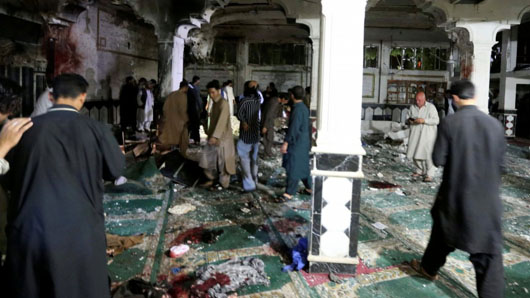by WorldTribune Staff, August 3, 2017
Attacks on the Iraqi embassy in Kabul and a Shi’ite mosque in Herat have raised concerns that jihadists are leaving the battlefields of Syria and entering Afghanistan through Iran.
In the July 31 attack in Kabul, a jihadist blew himself up outside the gates of the Iraqi embassy, enabling three gunmen to storm into the building, setting off a four-hour firefight that ended after Afghan security forces killed the attackers.

Islamic State (ISIS) has claimed responsibility.
Afghan Interior Ministry spokesman Najib Danish told reporters that two Afghan employees of the Iraq embassy died in the attack and three police were injured.
ISIS also claimed responsibility for an attack on the Jawadia Mosque in Herat in western Afghanistan that killed 29 people and wounded at least 60. Local officials said a jihadist opened fire on worshipers inside the mosque before detonating his explosives.
A senior Afghan security official told Reuters the number of foreigners fighting for both ISIS and the Taliban in Afghanistan is roughly 7,000. Most operate across the border from their home countries of Pakistan, Uzbekistan or Tajikistan, but also include others from countries such as India, the official said.
“We are not talking about a simple militant fighter, we are talking about battle-hardened, educated and professional fighters in the thousands,” the security official said. “They are more dangerous because they can and will easily recruit fighters and foot soldiers here.”
Juma Gul Hemat, police chief of Kunar, an eastern province bordering ISIS’s Nangarhar province stronghold, said that “In recent operations, we have inflicted heavy losses on them but their focus is to recruit fighters from this area.”
“They are not only from Pakistan or former Taliban, there are fighters from other countries and other small groups have pledged their allegiance to them,” Hemat said.
Afghan intelligence documents reviewed by Reuters show that security officials believe ISIS is present in nine Afghan provinces, from Nangarhar and Kunar in the east to Jawzjan, Faryab and Badakhshan in the north and Ghor in the central west.
The Trump administration has indicated it is considering sending more troops to Afghanistan.
According to reports, during a July 19 meeting in the White House Situation Room, President Donald Trump demanded that his top national security aides provide more information on what one official called “the end-state” in Afghanistan.
“The meeting grew stormy when Trump said Defense Secretary James Mattis and Joint Chiefs of Staff Chairman Joseph Dunford, a Marine general, should consider firing Army General John Nicholson, commander of U.S. forces in Afghanistan, for not winning the war,” Reuters reported.
“We aren’t winning,” Trump told Mattis and Dunford, according to officials who spoke on condition of anonymity.
Subscribe to Geostrategy-Direct __________ Support Free Press Foundation
